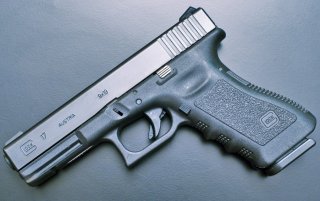Heated Debate: Is the Glock 17 Gun Better Than the Old School 1911A1?
The Glock was one of the first “Wonder Nines,” a term used to describe high-capacity nine-millimeter Luger semiautomatic pistols that became popular in the 1980s.
Here's What You Need to Remember: The appeal of the Glock handgun is almost entirely practical and without sentiment. The Glock simply works, and it works well. But how does it stack up?
Over the past hundred years there have been two guns that have defined semiautomatic pistols in the United States. The Colt M1911A1, now popularly known as the 1911, and the Glock 17, which were designed seventy years apart and each dominated the market for decades that followed. Both are still popular handguns in a market crowded with choices, and both still have a loyal, enduring following. What makes each gun different and unique from the other?
(This first appeared last year.)
The 1911 handgun was originally designed by prolific firearms inventor John Moses Browning to utilize the heavier .45 ACP (Automatic Colt Pistol) round. The 1911 included a number of innovations that were later incorporated into other pistols—including the Glock 17—such as Browning’s short recoil locked breech operating system, which made the use of heavier calibers possible in a relatively small and lightweight package. The large 230 grain .45 ACP round imparts more energy in foot pounds against the target than other contemporary rounds at the time of its introduction and still today. Internally the 1911 was a straightforward design for its time but today is regarded as relatively complicated.
One of the major advantages of the 1911 is that it can be carried in so-called “Condition One” status with a loaded magazine, round in the chamber, hammer back, and the safety on. This is considered the only safe way to carry a loaded 1911 and only requires the gripping the pistol (to engage the grip safety) and depressing the safety to fire. The 1911 is also remarkably slim, lending itself to concealed carry.
Over the years the appeal of the 1911 has evolved. While the 1911 is still a hard-hitting gun, other pistols are now on the market that carry more .45 ACP rounds and have softer felt recoil. The 1911 is no longer a high-tech by any means but a piece of history with practical, self defense value. The 1911 has served through more conflicts than any other and has a cachet that modern polymer pistols do not. Continuously updated even now through the twenty-first century the 1911 is still a useful handgun, although shortcomings such as magazine size and relatively complex disassembly will never be rectified.
The Glock 17 was invented in the early 1980s by Gaston Glock to compete in the Austrian Army handgun competition. The Glock was one of the first “Wonder Nines,” a term used to describe high-capacity nine millimeter Luger semiautomatic pistols that became popular in the 1980s. The Glock 17 was an amalgamation of many different handgun ideas, including the short recoil locked breech system of the 1911. In many ways the Glock 17 is the 1911’s heir—a revolutionary handgun with widespread military adoption.
The Glock 17 is a polymer frame, steel slide handgun that takes seventeen rounds in a double-stacked magazine. The weight savings by using essentially a plastic frame reduces the pistol weight to just over two pounds loaded. The gun was designed for reliability, simplicity, and “pointability” (the ability to point the handgun as a natural extension of your body). A Glock handgun can be field stripped from a loaded firearm in a matter of seconds for cleaning.
Recommended: Air War: Stealth F-22 Raptor vs. F-14 Tomcat (That Iran Still Flies)
Recommended: A New Report Reveals Why There Won't Be Any 'New' F-22 Raptors
Recommended: How an ‘Old’ F-15 Might Kill Russia’s New Stealth Fighter
The appeal of the Glock handgun is almost entirely practical and without sentiment. The Glock simply works, and it works well. The Glock is available in a variety of calibers and configurations, from service models meant to dangle from utility belts to subcompacts tucked under clothing. Unlike the 1911, the Glock is new enough that it lacks a grounding in history—except perhaps as the disruptor of an older order dominated by the 1911.
There is a temptation to directly compare the 1911 and Glock handguns, but the two really are a form of apples and oranges. The 1911 is a historical artifact with a level of modern utility as a tool. The Glock is a modern tool. Some people enjoy apples, others enjoy oranges, and others still enjoy both.
Kyle Mizokami is a defense and national security writer based in San Francisco who has appeared in the Diplomat, Foreign Policy, War is Boring and the Daily Beast. In 2009 he cofounded the defense and security blog Japan Security Watch. You can follow him on Twitter: @KyleMizokami.
Image: Flickr

